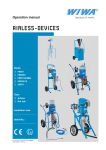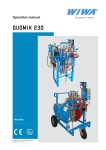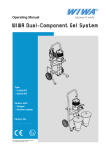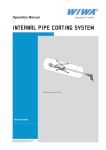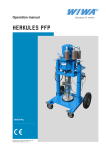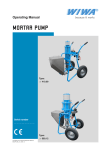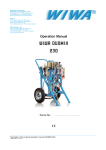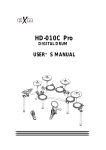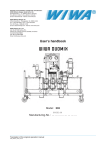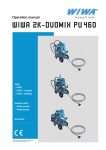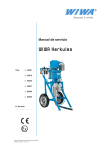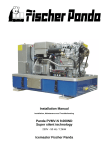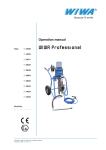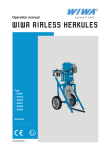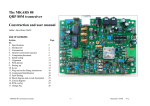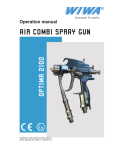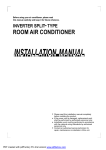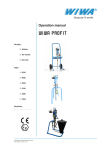Download Operation manual POLYESTER-UNIT
Transcript
Operation manual POLYESTER-UNIT Serialnumber ⸏⸏⸏⸏⸏⸏⸏⸏ Translation of the original operation manual Polyester-Anlage_en_1308 • jw Content Content 1 Foreword......................................................................................................5 2 Safety...........................................................................................................6 2.1 Explanation of symbols.............................................................................6 2.2 Safety notes..............................................................................................8 2.2.1 Operating pressure.........................................................................8 2.2.2 Risks due to the spray jet...............................................................8 2.2.3 Risks due to electrostatic charge....................................................9 2.2.4 Explosion protection.......................................................................9 2.2.5 Health risks...................................................................................10 2.3 Information signs on the equipment........................................................ 11 2.4 Safety features........................................................................................ 11 2.4.1 Compressed air shut-off valve......................................................12 2.4.2 Safety valves................................................................................12 2.4.3 Grounding cable...........................................................................13 2.4.4 Pressure relief valves...................................................................13 2.4.5 Spray gun lock..............................................................................13 2.5 Operating and maintenance personnel...................................................13 2.5.1 Obligations of the machine owner................................................13 2.5.2 Personnel qualification..................................................................14 2.5.3 Authorized operating personnel....................................................14 2.5.4 Personal Protective Equipment (PPE)..........................................14 2.6 Notes on warranty...................................................................................15 2.6.1 Conversions and alterations.........................................................15 2.6.2 Accessories and spare parts.........................................................15 2.7 Emergency procedures...........................................................................15 2.7.1 Shutting down and depressurising the machine...........................15 2.7.2 Leakages......................................................................................16 2.7.3 Injuries..........................................................................................16 3 Machine description...................................................................................17 3.1 Intended use...........................................................................................17 3.2 Machine configuration.............................................................................18 3.3 Intermediate piece..................................................................................20 3.4 Air maintenance unit...............................................................................21 3.5 Pressure and dosing control...................................................................21 3.6 Mixing unit...............................................................................................22 3.7 Feed pump (optional)..............................................................................23 4 Transport, installation and assembly.........................................................24 4.1 Transport.................................................................................................24 4.2 Installation location.................................................................................24 Translation of the original operation manual Polyester-Anlage_en_1308 • jw 3 Content 4.3 Assembly................................................................................................25 4.3.1 Assembling the hose package......................................................26 4.3.2 Assembling handle bar.................................................................26 4.3.3 Assembling spraying hose and spray gun....................................27 4.3.4 Connecting the compressed air supply.........................................27 4.3.5 Connecting the feed pump (optional) ...........................................28 5 Operation...................................................................................................29 5.1 Taking the system into service................................................................29 5.1.1 Preparing the flushing pump.........................................................29 5.1.2 Filling / circulating the machine.....................................................30 5.1.3 Filling the hose package...............................................................31 5.2 Volumetric measurement........................................................................31 5.3 Setting the hardener metering quantity (beam pump)............................32 5.4 Coating...................................................................................................32 5.4.1 Setting the spraying pressure.......................................................33 5.4.2 Adjusting the pressure and dosing control....................................34 5.4.3 Tips for good coatings...................................................................35 5.5 Flushing..................................................................................................35 5.6 Decommissioning / Empty containers.....................................................36 5.7 Waste disposal........................................................................................37 6 Maintenance..............................................................................................38 6.1 Regular inspections................................................................................38 6.2 Maintenance plan...................................................................................39 6.3 Air maintenance unit...............................................................................40 6.3.1 Checking the lubricant level in the fog oiler..................................40 6.3.2 Checking and adjusting the fog oiler............................................41 6.3.3 Checking and cleaning the water separator.................................41 6.4 Main pump and beam pump...................................................................41 6.4.1 Checking the packaging of the main pump and the beam pump.41 6.4.2 Filling the main pump with release agent.....................................42 6.5 High pressure filter..................................................................................42 6.5.1 Cleaning the filter element on the high pressure filter..................42 6.5.2 Filter elements for high pressure filters.........................................43 6.6 Feed pump (optional)..............................................................................44 6.6.1 Filling the feed pump with release agent......................................44 6.6.2 Check the condition of the packing and adjust packing................44 6.7 Recommended operating materials........................................................45 6.8 Special tools...........................................................................................45 7 Malfunctions and Troubleshooting.............................................................47 8 Technical data............................................................................................49 8.1 Machine card..........................................................................................49 8.2 Type plates..............................................................................................49 4 Translation of the original operation manual Polyester-Anlage_en_1308 • jw Foreword 1 Foreword Dear Customer! We are delighted about your decision to buy one of our machines. This operating manual is intended for the operating and maintenance personnel. It contains all information required to operate and handle this machine. The owner of the machine must ensure that the operator of the machine always has an operating manual at his/her disposal in a language he/she understands! Safe and reliable operation of the system requires further information in addition to this operating manual. ➤➤ Read and comply with the applicable guidelines for your country. In Germany, these are the “Richtlinien für Flüssigkeitsstrahler” (Guidelines for Liquid Jets), issued by: the Hauptverband der Gewerblichen Berufsgenossenschaften. ➤➤ Moreover the manufacturer‘s instructions and guidelines for coating or feeder materials are to be respected at all times. We strongly recommend to add all relevant guidelines and accident prevention instructions to this operating manual. However, if you have any questions, please do not hesitate to contact us. Excellent work results wishes WIWA Wilhelm Wagner GmbH & Co. KG Copyright © 2013 WIWA Copyright ownership for this operating manual remains with WIWA Wilhelm Wagner GmbH & Co. KG Gewerbestr. 1-3 • 35633 Lahnau • Germany Phone: +49 6441 609-0 • Fax: +49 6441 609-50 E-Mail: [email protected] • Homepage: www.wiwa.de This operating manual is solely intended for personnel involved in preparation, operation and servicing. It is prohibited to pass on this operating manual for reproduction, utilisation or communication of its contents, unless this has been explicitly permitted. Infringements incur an obligation to pay damage compensation. All rights reserved in the event of registration of the patented design, industrial design or registered design. This operating manual only applies in conjunction with the machine card that was given to you with the user manual for your equipment. Please check that the type plate data is identical with the information on the machine card. Please notify us immediately if there are discrepancies, if the user manual has been incorrectly compiled or if the type plate is missing. Translation of the original operation manual Polyester-Anlage_en_1308 • jw 5 Safety 2 Safety This machine has been designed and manufactured while taking into consideration all safety-related aspects. It corresponds to the current standard of technology and to applicable accident prevention regulations. The machine left the factory in perfect condition and guarantees a high level of technical reliability and safety. Nevertheless, there are certain risks that can arise from incorrect operation or misuse: ➤➤ to life and limb of the operator or third party, ➤➤ to the machine and other material assets of the owner, ➤➤ to the efficient working capacity of the machine. In principle you should refrain from any work method that could affect the safety of operating personnel and equipment. All persons involved in set-up, commissioning, operation, maintenance, repair and servicing of the machine must have read and understood the operating manual beforehand, especially the chapter “Safety”. Your safety is at stake! We recommend to the owner of this machine to have this confirmed in writing. 2.1 Explanation of symbols Safety notes warn of potential accident hazards and identify the necessary measures to prevent accidents. In the operating manuals from WIWA safety notes are particularly highlighted and marked as follows: DANGER Highlights accident hazards which if disregarding the safety note will result most likely in severe or even fatal injuries! WARNING Highlights accident hazards which if disregarding the safety note can result in severe or even fatal injuries! CAUTION Highlights accident hazards which if disregarding the safety note can result in injuries! Highlights important information for the proper use of the equipment. Disregarding this information can result in damage to the equipment or to the environment. 6 Translation of the original operation manual Polyester-Anlage_en_1308 • jw Safety Depending on the hazard source different pictograms are used in safety notes about accident hazards with risk of injury – examples: General accident hazard Risk of explosion from explosive atmospheres Risk of explosion from explosive substances Accident hazard from voltage or static electricity Danger of crushing from moving machine parts Risk of burns from hot surfaces Security orders primarily indicated to wear protective equipment. They are also highlighted and marked as follows: Wear protective clothing Highlights the order to wear the prescribed protective clothing to protect against skin injuries caused by spraying material or gases. Use eye protection Highlights the order to use eye protection in order to prevent your eyesigh from being damaged by material splatter, gases, vapors or dust. Wear ear defenders Highlights the order to use ear defenders in order to prevent your sense of hearing from being damaged by noise. Use a respiratory protection mask Highlights the order to use a respiratory protection mask in order to prevent your respiratory tract from being damaged by gases, fumes or dusts. Wear protective gloves Highlights the order to wear protective gloves with lower arm protection to protect against burn injuries caused by heated materials. Wear protective footwear Highlights the order to wear protective footwear to prevent injuries to the feet due to tumbling, falling or rolling objects, and a slip on slippery surfaces. Reading is an absolute must Highlights references to guidelines, work and operating manuals, which must be strictly followed. Translation of the original operation manual Polyester-Anlage_en_1308 • jw 7 Safety 2.2 Safety notes Please remember that the machine works with high pressures and may cause life threatening injuries if used inappropriately! Always observe and follow the information in this operating manual as well as in the separate operating manuals for individual system components or the optionally available accessories. The accident prevention instructions „Application of Coating Materials“ (BGR 500, chapt. 2.29) and the guidelines for liquid jets ZH1/406 of the employer‘s liability insurance association must strictly be complied with. 2.2.1 Operating pressure WARNING Components that do not comply with the maximum permissible operating pressure may burst und cause severe injuries. ➤➤ The specified maximum operating pressures must generally be complied with for all components. In case of varying operating pressures the lowest value is always valid as the maximum admissible operating pressure for the entire system. ➤➤ Material hoses and hose assemblies must comply with the maximum working pressure, including the required safety factor. ➤➤ Material hoses must be leak tight and free of kinks, signs of abrasion or bulges. ➤➤ Hose connections must be tight. 2.2.2 Risks due to the spray jet WARNING The material is discharged from the spray gun under very high pressure. Due to its cutting effect the spray jet can cause severe injuries by penetrating the skin or entering into the eyes. ➤➤ Never point the spray gun at yourself, other persons or animals! ➤➤ Do not hold your fingers or hands in front of the spray gun! ➤➤ Do not reach with your hands into the spray jet! WARNING Any unintended escape of material from the spray gun can cause damage to persons or property. ➤➤ Always secure the spray gun, even for shortest work breaks! ➤➤ Always make sure that the spray gun is properly secured before each use! 8 Translation of the original operation manual Polyester-Anlage_en_1308 • jw Safety 2.2.3 Risks due to electrostatic charge WARNUNG The high flow velocities associated with the Airless spraying method may cause static charging. Static discharges can cause fire and explosion. ➤➤ Always use open containers! ➤➤ Never spray solvents or solvent containing materials into cone-top cans or drums with bunghole! ➤➤ Stand the containers on a grounded surface. ➤➤ When using metal containers watch out for contact between spray gun and container wall. ➤➤ Only use conductive material hoses. All original material hoses from WIWA are conductive and perfectly adapted to our equipment. 2.2.4 Risk of crushing Fig. 2.1 Risk of crushing CAUTION Hands/fingers can be crushed between the material container and the cover plate when it closes. ➤➤ Do not reach between cover plate and container, when you open or close the container. ➤➤ Always open the cover plate completely to prevent it from falling. Translation of the original operation manual Polyester-Anlage_en_1308 • jw 9 Safety CAUTION Hands/fingers can be crushed in the area of the beam system, while the pump is running. ➤➤ Do not reach between the piston of the main pump and the moving beam. ➤➤ Do not reach between beam pump and the front bar, when the beam pump is in the forward position (1 %-position). 2.2.5 Explosion protection WARNING Equipment designed without explosion protection must not be used in workshops that come under the explosion protection ordinance! Explosion protected systems fulfil the explosion protection requirements of the Directive 94/9/EC for the explosion group, machine category and temperature class specified on the type plate or in the declaration of conformity. The operator is responsible for determining the zone allocation according to the Directive of EC 94/9/EC, Appendix II, no. 2.1-2.3 when observing the measures of the responsible inspecting authority. The operator is responsible for checking and ensuring that all technical data and markings according to ATEX correspond with the necessary requirements. Please note that several components have their own type plate with separate marking according to ATEX. In this case the lowest explosion protection of all attached markings applies for the entire system. Applications where the malfunction of the machine can lead to danger to personnel must be provided with respective safety measures by the operator. However, if agitators, heaters or other electrically accessories are additionally mounted, one must check the explosion protection. Plugs for heaters, agitators, etc. that do not have explosion protection, may only be plugged in outside of areas that fall under the explosion protection ordinance, even if the accessory equipment as such is explosion protected. WARNING The heating of cleaning agents can cause an explosion. Serious injuries and property damage can result. ➤➤ Observe the flash point and ignition temperature of the cleaning agent. ➤➤ Turn off all material heaters and allow them to cool before performing any of the following work: cleaning, pressure testing, decommissioning, maintenance and repair. 10 Translation of the original operation manual Polyester-Anlage_en_1308 • jw Safety 2.2.6 Health risks Follow the safety notes and dosing information of the manufacturer and the generally applicable regulations when handling paints, solvents, oils, greases and other chemical substances. CAUTION Depending on the materials being applied solvent vapours may be generated which could cause damage to health and objects. ➤➤ Always ensure sufficient aeration and ventilation at the workplace. ➤➤ Always observe the processing instructions issued by the material manufacturers. Use only appropriate skin protection, skin cleaning and skin care products. In closed or pressurized systems dangerous chemical reactions may occur if parts made of aluminium or galvanized parts come into contact with 1.1.1 trichloroethane, methylene chloride or other solvents containing halogenated hydrocarbons (CFC’s). If you want to process materials containing the afore mentioned substances, we recommend to consult the material manufacturer to clarify the usability of such substances. For these materials we have a range of rust and acid proof versions available. 2.3 Information signs on the equipment Information signs attached to the equipment, such as safety information (see Fig. 1) refer to possible danger areas and must be strictly followed. They must not be removed from the equipment. Damaged and illegible information signs must be replaced immediately. Apart from this you should also read and follow the safety notes in the operating manual. Fig. 1: Safety Information Translation of the original operation manual Polyester-Anlage_en_1308 • jw 11 Safety 2.4 Safety features WARNING If one of the safety features is missing or not fully functional, the operating safety of the system cannot be guaranteed! ➤➤ If you discover any faults on the safety features or other deficiencies on the system, stop operation of the system immediately. ➤➤ Only resume operation of the system after the fault has been completely rectified. Safety features must be checked with the system depressurized: ➤➤ before initial commissioning, ➤➤ always before starting work, ➤➤ after completion of setup work, ➤➤ after cleaning, maintenance and repair work! Check list: 55 Lead seal on the safety valve still intact? 55 Safety valves externally free of damage? 55 Grounding cable free of damage? 55 Correct functioning of safety levers on spray gun? 55 Function of compressed air shut-off valve correct? The system is equipped with the following safety features: ➤➤ compressed air shut-off valve, ➤➤ safety valve, ➤➤ grounding cable, ➤➤ pressure relief valve, ➤➤ spray gun lock. 2.4.1 Compressed air shut-off valve The red compressed air shut-off valve on the air maintenance unit interrupts the air supply for the entire system. The functional principle of all pressure and material shut-off valves is identical: ➤➤ open set in flow direction ➤➤ close set across the flow direction Fig. 2: compressed air shutoff valve closed Once the air supply is cut off, the system is still under pressure. Before starting maintenance and repair work, you must therefore release the pressure completely using the high pressure filter and spray gun! 12 Translation of the original operation manual Polyester-Anlage_en_1308 • jw Safety 2.4.2 Safety valves The machine is equipped with safety valves: ➤➤ at the air maintenance unit, ➤➤ at the air motors of the material pump the flushing pump the feed pump (optional) The safety valves ensure that the max. permissible air inlet pressure is not exceeded. Fig. 3: safety valve If the air inlet pressure exceeds the fixed limiting value at one of the points mentioned above, the corresponding safety valve will blow off. WARNING If the maximum permissible air inlet pressure is exceeded, components may burst. This may result in damage to persons and property. ➤➤ Never allow the system to run without or with defective safety valves! ➤➤ If a safety valve needs to be replaced, you can find the corresponding order number on the machine card. ➤➤ When using new safety valves make sure that the valves have been set to the max. permissible air inlet pressure of the machine as required for the mixing ratio (see type plate or machine card) and sealed with a lead seal. 2.4.3 Grounding cable The system must be earthed to an electrically conductive object with the grounding cable to prevent electrostatic charging. The high pressure filter is fitted with an earthing screw for this purpose. An adhesive label on the high pressure filter expressly indicates the required earthing. Fig. 4: Grounding cable 2.4.4 Pressure relief valves Both components are equipped with a pressure relief valve that opens when the permissible operating pressure is exceeded and allows the material to flow back into the material container. The pressure relief valves for both components are found to the right and left on the adapter. The corresponding ordering data is found on the machine card Translation of the original operation manual Polyester-Anlage_en_1308 • jw Fig. 5: Pressure relief valves 13 Safety 2.4.5 Spray gun lock The spray gun must always be secured against unintended operation, even for the shortest of work breaks. Set the safety lever horizontally to secure the spray gun. Fig. 6: Spray gun lock 2.5 Operating and maintenance personnel 2.5.1 Obligations of the machine owner The owner of the machine: ➤➤ is responsible for training the operating and maintenance personnel, ➤➤ must direct the operating and maintenance personnel to handle the plant appropriately and to wear correct work clothes and protective equipment, ➤➤ must make the user manual accessible to the operating and maintenance personnel and ensure that it remains available at all times, ➤➤ must ensure that the operating and maintenance personnel have read and understood the user manual. Only then the machine may be taken into service. 2.5.2 Personnel qualification A differentiation is made between two groups of people in dependence on their qualifications: ➤➤ Instructed operators have been verifiably instructed by the plant owner in the activities they are tasked with and the potential risks connected with them in the case of incorrect behaviour. ➤➤ Trained personnel have been instructed by the plant manufacturer such that they are capable of carrying out maintenance and repair work on the system and recognising potential risks on their own initiative and of avoiding these risks. 2.5.3 Authorized operating personnel Activity Qualification Setup and operation Instructed operators Cleaning Instructed operators Servicing Trained personnel Repair Trained personnel Juveniles under the age of 16 have no permission to operate this equipment. 14 Translation of the original operation manual Polyester-Anlage_en_1308 • jw Safety 2.5.4 Personal Protective Equipment (PPE) Wear protective clothing Always wear the protective clothing prescribed for your work environment (mining, closed rooms, etc.) and follow the recommendations in the safety data sheet issued by the material manufacturer. Use eye protection Wear protective goggles to protect against eye injuries caused by material splatter, gases, vapors or dust. Wear ear defenders Operating personnel should be provided with suitable noise protection equipment. The operator is responsible for adhering to the accident prevention regulation “Noise” (BGV B3). For this purpose, pay special attention to the conditions of the installation location – the noise burden will increase if the system is installed in or on hollow bodies. Use a respiratory protection mask We strongly recommend to wear a respiratory protection mask, even though the paint mist has been minimized in Airless spray painting applications with correct pressure setting and working mode. Wear protective gloves When applying heated materials you should wear protective gloves with lower arm protection to prevent burns. Wear protective footwear Wear protective footwear to prevent injuries to the feet due to tumbling, falling or rolling objects, and a slip on slippery surfaces. 2.6 Notes on warranty 2.6.1 Conversions and alterations ➤➤ Unauthorized conversions or alterations should not be undertaken on safety grounds. ➤➤ Protective equipment should not be dismantled, converted or bypassed. ➤➤ Use of components which have not been manufactured or delivered by WIWA renders any warranty null and void. ➤➤ The unit should only be operated within the prescriptive limit values and machine parameters. 2.6.2 Accessories and spare parts ➤➤ If you use original accessories and spare parts from WIWA, their suitability for use with our equipment is guaranteed. ➤➤ It is, however, mandatory to respect the safety regulations of the accessories and spare parts. You will find these safety regulations in the corresponding operating manuals for the accessories and spare parts. Translation of the original operation manual Polyester-Anlage_en_1308 • jw 15 Safety ➤➤ If foreign accessories or spare parts are used, the company WIWA cannot guarantee the safety of the entire system. Liability for damages or injuries incurred because of the use of those accessories and spare parts becomes null and void. 2.7 Emergency procedures 2.7.1 Shutting down and depressurising the machine In an emergency, the machine must be shut down and depressurised immediately. Releasing the pressure: 1. Completely reduce the air inlet pressure (0 bar). 2. Open the compressed air shut-off valve on the air maintenance unit. 3. Open the drain valve on high pressure filter A or the pressure release valve on the B-component. 4. Operate the spray gun once again for a moment to relieve any material pressure and completely release the pressure from the machine. 2.7.2 Leakages WARNING In case of leakages material can escape under very high pressure and cause serious bodily injuries and material damage. ➤➤ Shut down and depressurize the system immediately. ➤➤ Re-tighten the connections and replace defective components (only by trained personnel). ➤➤ Do not seal leakages on connections and high pressure hoses by hand or by wrapping fabric around them. ➤➤ Do not repair material hoses! ➤➤ Check hoses and connections for leaks before restarting. 2.7.3 Injuries If injured by processing materials or solvents always have the safety data sheet (address of supplier or manufacturer, his phone number, material designation and material number) available for the attending physician. 16 Translation of the original operation manual Polyester-Anlage_en_1308 • jw Machine description 3 Machine description The machine works according to the “Master-Slave Principle”, i.e. only the material pump for the A-component is directly driven and the beam pump for metering the B-component is then driven along with this. The upper, rigid beam is fixed to the frame. The lower, moveable beam is attached to the adapter of the material pump and thus automatically performs the movement of the material pump. The metering pump is installed between these two beams. The hardener is metered in undiluted state and can be infinitely set with a ratio of 1 to 3 %. The bigger the distance of the metering pump to the material pump, the smaller the stroke and the smaller the mixing ratio – and vice versa. The technical data for your machine can be found in the attached machine card. 3.1 Intended use The machine is intended for metering coating materials, to which a catalyst is mixed at a ratio of between 1 and 3 % (such as polyester resins with glass flakes mixed with peroxide). Any other use is considered unintended. Should you intend to use the system for other purposes or with other materials and thus not for the purpose it is intended for, you must ask WIWA for permission – otherwise warranty will become null and void. Intended use also includes compliance with the technical documentation and adherence to the prescribed operating, servicing and maintenance guidelines. Translation of the original operation manual Polyester-Anlage_en_1308 • jw 17 Machine description 3.2 Machine configuration 1 6 2 7 3 4 8 9 10 11 12 5 Fig. 7: Front view of polyester unit No. Description 1 Air motor 3 High pressure filter of A-component 2 4 5 6 7 8 9 10 11 12 18 Intermediate piece Return hose A-component Material container for A-component (60 l) Material container for B-component (4,8 l) Material pump for B-component (metering beam pump) fastened to material pump A (11) using a beam and moved together with this pump Pressure control unit for regulating the air inlet pressure for the flush pump and material pump(s). Drain valve for pressure release START button Switch for selecting manual or automatic operating mode Material pump for A-component Translation of the original operation manual Polyester-Anlage_en_1308 • jw Machine description 12 15 13 14 16 Fig. 8: Rear view of polyester unit No. Description 13 Maintenance unit 15 Drain cock to empty the material container of A-component 14 16 17 Translation of the original operation manual Polyester-Anlage_en_1308 • jw Air pressure regulator with filter Flush pump Mobile frame (optional) 19 Machine description 3.3 Intermediate piece 5 6 2 3 7 4 1 8 15 14 13 12 11 9 10 Fig. 9: Intermediate piece No. Description 1 Pressure release valve “A” 3 Release agent hose connection 2 4 5 6 7 8 9 10 11 12 13 14 15 20 Material hose connection for A-component Material hose connection for B-component Contact pressure gauge for pressure monitoring of B-component Volume control for B-component (volumetric measurement) Ball valve “Volumetric measurement B” Return hose connection “B” Pressure release valve “B” Pressure gauge on material inlet for B-component Inlet for B-component Inlet for flushing Inlet for A-component Pressure gauge on material inlet for A-component Return hose connection “A” Translation of the original operation manual Polyester-Anlage_en_1308 • jw Machine description 3.4 Air maintenance unit 1 2 3 4 7 8 closed 6 Fig. 10 Two-piece air maintenance unit 5 open No. Description 1 fog oiler sight galss 3 oil filler opening 2 4 5 6 7 8 fog oiler adjusting screw compressed air distributor compressed air shut-off valve water separartor with automatical drain valve oiltank pneumatic valve for air motor 3.5 Pressure and dosing control 1 3 2 4 Fig. 11: Pressure and dosing control No. Description 1 Air pressure regulator with filter 3 “START” button 2 4 Translation of the original operation manual Polyester-Anlage_en_1308 • jw Precision pressure regulator “MANUAL / AUTOMATIC” switch 21 Machine description 3.6 Mixing unit 3 4 5 2 1 6 7 8 Fig. 12: Mixing unit closed (OFF) No. Description 1 Material hose connection for component A 3 Flushing hose connection 2 4 5 6 7 8 Fig. 13 Spray ON 22 Spray lever OFF / ON Material hose connection for component B Ball valve for flushing component B Ball valve for flushing component A Static mixer Spraying hose connection Fig. 14 Flush component A Fig. 15 Flush component B Translation of the original operation manual Polyester-Anlage_en_1308 • jw Machine description 3.7 Feed pump (optional) The machine can optionally be operated with a feed pump instead of the 60 l container. The material (component A) is thereby sucked in with the help of the supply directly from the packaging (eg 200 liter barrel). 1 2 3 9 8 4 5 6 7 10 Fig. 16 Composition of the machine with optional feed pump No. Description 1 air inlet pressure gauge of feed pump 3 compressed air regulator 2 4 5 6 7 8 9 10 Translation of the original operation manual Polyester-Anlage_en_1308 • jw compressed air connection fitting of feed pump in the bung hole of the barrel outlet manifold circulation / return material hose with ball valve return hose ball valve for pressure relief materialconnection at the unit 23 Transport, installation and assembly 4 Transport, installation and assembly The machine has left the factory in flawless condition and was appropriately packed for transport. Upon arrival you should check the machine for completeness and any apparent transport damage. 4.1 Transport The system is mounted on a mobile frame, which is equipped with a parking brake on the front wheel. Fig. 17: Mobile frame (optional) Please follow these notes when transporting the equipment: ➤➤ Do not transport any other objects (e.g. material containers) when lifting the equipment. ➤➤ Never stand under suspended loads or inside the loading area. This poses a life hazard! ➤➤ Secure the load on the transport vehicle against slipping and falling off. If the system has already been in use, you should observe the following notes: ➤➤ Disconnect the entire system power supply – even for short transport distances. ➤➤ Empty the system before transportation – fluid residues may escape during transport, despite this measure. ➤➤ Remove all loose components (e.g. tools) from the unit. ➤➤ Assemble the parts or fittings dismantled for transport purposes before start up and in compliance with the intended use of the system. 4.2 Installation location The system is intended for installation outside explosion-endangered environments. Only systems of special explosion protected design may be installed inside EX-environments. The system should preferably be installed outside the immediate spraying area to avoid contamination. 24 Translation of the original operation manual Polyester-Anlage_en_1308 • jw Transport, installation and assembly WARNING If operating an outdoor system during a thunderstorm, a lightning can cause a life-threatening situation for the operating personnel. ➤➤ Do not operate an outdoor system during a thunderstorm! ➤➤ The owner must protect the system by applying appropriate lightning protection measures. Place the system horizontally on a surface which is level, firm and free of vibration. The system must not be tilted or inclined. All controls and safety features must be easily accessible. Safety measures at the place of installation: ➤➤ This system requires a solid base and sufficient free space for safe operation. ➤➤ Secure the equipment at its final location to protect it against unintended movement. To do this, kick down the wheel brake on the frame (see Fig. 18). Before transportation, pull up the wheel brake to release. Fig. 18: Wheel brake ➤➤ Always keep the working area, especially all walkways and standing areas, clean and tidy. Immediately remove any spilled material and solvents immediately. ➤➤ Always ensure adequate ventilation at the work place to avoid damage to health and material objects. ➤➤ Always observe the processing instructions issued by the material manufacturers. ➤➤ Even though there are no legal directives for low-mist Airless spraying methods, all hazardous solvent vapours and paint particles should be extracted. ➤➤ Protect objects adjacent to the spraying object against possible damage caused by the material mist. 4.3 Assembly Some machine components are packed separately for transportation. Please assemble these parts again before using the equipment for the first time. WARNING If installation work is carried out by persons who have not been trained for this work you endanger yourself, other persons and impair the safety and reliability of the machine. ➤➤ Installation work on the control cabinet and other live components must only be performed by skilled electricians – any other installation work (e.g. assembling spraying hose and spray gun) only by specially trained personnel. Translation of the original operation manual Polyester-Anlage_en_1308 • jw 25 Transport, installation and assembly 4.3.1 Assembling the hose package WARNING If the hose package couplings are subjected to tensile load, these assemblies may be torn out. Material escaping under high pressure can cause injuries and material damage. ➤➤ If tensile loads on the hose package couplings are to be expected (e.g. by positioning the mixing unit), a strain relief is required! If the hose package is too tightly bent, hoses may buckle inside the hose package. ➤➤ The minimum bending radius of 30 cm must not be fallen short of! A F B A F B Fig. 19 Assembling the hose package at the intermediate piece F A B Fig. 20 Assembling the hose package at the mixing unit No. Description A Material hose (Component A) F Flushing hose B Material hose (Component B) 4.3.2 Assembling handle bar The handle bar was not fitted for shipping because of reasons of space. ➤➤ Screw the handle bar to the frame (refer Fig. 7). The matching screws are located on the frame. 26 Translation of the original operation manual Polyester-Anlage_en_1308 • jw Transport, installation and assembly 4.3.3 Assembling spraying hose and spray gun WARNING Components that do not comply with the maximum permissible operating pressure may burst und cause severe injuries. ➤➤ Before assembling, check the maximum permissible pressure for the separately packaged components and accessories. lt must be higher than or equal to the maximum operating pressure of the system as specified on the machine type plate. ➤➤ Connect the spray gun used (e.g. WIWA 500 D Airless) to the static mixer using a suitable material hose (see also chapter 3.6 Mixing unit). Spraying hose Spray gun Fig. 21 Install the spraying hose and spray gun on the static mixer of the mixing unit 4.3.4 Connecting the compressed air supply To ensure an adequate air supply, the compressor capacity must match the air requirements of the unit and the diameters of the air supply hoses must match the inlet connections. Operation with contaminated or moist compressed air causes damage to the pneumatic system. ➤➤ Use only dried, oil- and dust-free air! 1. Connect the system to the customer’s compressed air supply. 2. Connect the system to the electric power supply (only for designs with electrical components such as material heaters). Fig. 22 Druckluftanschluss Translation of the original operation manual Polyester-Anlage_en_1308 • jw 27 Transport, installation and assembly 4.3.5 Connecting the feed pump (optional) 1. Fill the feed pump with release agent (1, Fig. 23) (s. Chap. 6.6.1 Filling the feed pump with release agent on page 44) 4 2. Determine the feed pump in the barrel through the bung hole and screw it (2, Fig. 23). 3 3. Screw the outlet manifold to the material outlet of the feed pump (3, Fig. 23). 1 2 5 Fig. 23 Connecting feed pump 4. Connect the air inlet of the feed pump (4, Fig.23) with the compressed air distributor at the maintenance unit (Fig. 24). 5. Connect the material hose to the outlet manifold (5, Fig. 23) and the other end to the free material inlet to the unit (10, Fig. 16). Fig. 24 compressed air distributor 28 Translation of the original operation manual Polyester-Anlage_en_1308 • jw Operation 5 Operation Before starting operation, check: 55 Are all safety features of the system present and fully functional? 55 Are all system components leak tight? If necessary, re-tighten the connections. 55 Is the oil reservoir of the fog oiler filled with an appropriate amount of lubricant? WARNING If material pumps run dry, the generated friction heat can cause fire or an explosion. ➤➤ Always make sure that the material drums do not run dry during operation. ➤➤ However, should this happen, stop the corresponding pump immediately and feed material. 5.1 Taking the system into service Requirements: ➤➤ The system must be properly placed (see 4.2 on page 24) and completely assembled (see 4.3 on page 25). ➤➤ Do not start commissioning the system unless you have the specified protective equipment. For details on this topic, refer to chapter 2.5.4 on page 15. ➤➤ The material to be applied must be available in sufficient quantities. Furthermore you need two appropriate containers for collecting excess material. These containers are not included in the scope of delivery. Pay attention to the manufacturer’s special notes and processing guidelines for the coating or feeding materials used. 5.1.1 Preparing the flushing pump During work the flushing pump should always be ready for use, so that all components, which come in contact with the mixed material, can be flushed within the specified potlife! 1. Place the suction of the flushing pump into a container with cleaning agent that matches the material to be applied. Follow the recommendations of the material manufacturer. 2. Open the flushing ball valves „A“ and „B“ on the mixing unit (see chapter 3.6 on page 22). 3. Close the pressure release valves “A” and “B” and the ball valve “Volumetric measurement B” (see chapter 3.3 on page 20). 4. Regulate the air inlet pressure on the flush pump to 2 bar ( “Flush pump” regulator). Translation of the original operation manual Polyester-Anlage_en_1308 • jw 29 Operation 5. Operate the spray gun and let the flush pump run at least until clean release agent comes out. 6. Close and secure the spray gun. 7. Close the flushing ball valves. 8. Leave the flushing pressure applied (no pressure discharge), the flushing pump is then ready for use at any time. 5.1.2 Filling / circulating the machine 1. Stir the component A (e.g. polyester resin with glassflake) well inside the delivered drum with an agitator 2. Fill the material into the 60 l container for A-component. or Put the feed pump (optional) into the delivered drum. 3. Fill component B (hardener or catalyst) into container B. CAUTION! You can be injured, when material squirts out. Wear your personnel protective equiupment. When filling in the components make sure that no dirt enters into the containers and is sucked in by the pumps. 4. For initial commissioning or material change: Unscrew the return hose on material container B and hold it in a container for contaminated material to flush out any residue of the customer’s test medium or the most recently used material (see point 5). 5. Open the pressure release valve “B” (see chap. 3.3 on page 20). 6. Loosen the pin above the handwheel on the lower bar of the beam pump and move the pump up and down by hand. 7. If you have removed the return hose on container B, reinstall it. 8. Pump by hand until no more air bubbles can be seen in the transparent return hose of the B-component. 9. Attach the beam pump with the pin on the beam. 10.For initial commissioning or material change: Remove the return hose from the container with A-component and hold it in a container for contaminated material to flush out any residue of the customer’s test medium or the most recently used material. 11.Regulate the air inlet pressure of the (optional) feed pump to 2,5-3 bar ( regulator on feed pump). 12.Regulate the air inlet pressure of the main pump to 2 bar ( “Main pump” regulator). 13.Open the pressure relief valve “A” . 14.Once clean material comes out of return hose “A”, close the pressure relief valves “A” and “B”. 30 Translation of the original operation manual Polyester-Anlage_en_1308 • jw Operation 15.If the return hose A was removed, connect it into the bracket on the material container for A-component and secure it against slip out. 16.Reduce the air inlet pressure. 5.1.3 Filling the hose package 1. Set the mixing unit to “SPRAY” (see chap. 3.6 on page 22). 2. Regulate the air inlet pressure of the (optional) feed pump to 2,5-3 bar ( regulator on feed pump). 3. Regulate the air inlet pressure of the main pump to 2 bar ( “Main pump” regulator). 4. Hold the gun into a container for contaminated material. Operate the gun without nozzle! 5. Operate the gun, until clean material comes out. 6. Close the lever “Spray” on the mixing unit. 5.2 Volumetric measurement The volumetric measurement serves the purpose of checking the metering quantity, especially of the hardener. The machine has to be filled before (s. Chap. 5.1.2 Filling / circulating the machine). 1. Drain the B-component from the volumetric measurement unit down to 10 ml (easier to read than 0 ml) by opening the ball valve “Volumetric measurement B” and the pressure relief valve “B”. 2. Close the pressure relief valve “B”. 3. optional: Regulate the air inlet pressure of the feed pump to 2,5-3 bar ( regulator on feed pump). 4. Hold a measuring cup underneath return hose A. Alternative: The hose can be removed from the container by loosening the wing screw. 5. Open the pressure relief valve “A”. 6. Increase the air inlet pressure of the main pump slowly ( “Main pump” regulator), until material runs out. 7. Close the pressure relief valve “A” after 1 l of component A has run out into the measuring cup. 8. Check the component B filling level in the volumetric measurement unit. 1 ml corresponds with 0.1 Vol.% of component B. If the volumetrically measured quantity of component B does not correspond with the desired metering (1 ml = 0.1 Vol.%), adjust the beam pump accordingly (see chapt. 5.3 Setting the hardener metering quantity (beam pump)) and repeat the volumetric measurement process . 9. Regulate the air inlet pressure back completely. 10.Open the pressure relief valve B and allow the B-component to run out to 10 ml. Translation of the original operation manual Polyester-Anlage_en_1308 • jw 31 Operation 5.3 Setting the hardener metering quantity (beam pump) The beam pump can be infinitely adjusted from 1 - 3 %. The bigger the distance of the metering pump to the material pump, the smaller the stroke and the smaller the mixing ratio. The closer the metering pump is displaced towards the material pump, the bigger the stroke and the higher the hardener metering quantity. Always make sure that the beam pump remains almost vertical between the beams. Any slanted position of the beam pump will result in higher wear of the seals. CAUTION No pressure should be applied! Relieve any pressure from the machine before starting to adjust the beam pump. 3 % 2 % 1. In case of a slight deviation from the desired mixing ratio, adjust the beam pump on the lower suspension by means of the hand wheel. 1 % 2. If more significant changes to the mixing ratio are required, also adjust the beam pump on the upper beam. ➤➤ Remove the pin and move the beam pump to the desired bore. ➤➤ Fix the pump again using the pin. Always make sure that the beam pump remains vertical. 3. Check the adjusted metering by volumetric measurement (s. Kap. 5.2 Volumetric measurement). 1 ml corresponds with 0.1 Vol.% of component B ↺ Fig. 25 Set the beam pump 5.4 Coating 1. Follow the instructions in chapter 5.1.1 Preparing the flushing pump and chapter 5.1.2 Filling / circulating the machine. 2. Check the following: –– Pressure relief valve “B” is closed –– Pressure relief valve “A” is closed –– Ball valve “Volumetric measurement B” is closed 3. Insert the nozzle into the spray gun. 4. Set the mixing unit to “SPRAY”. 32 Translation of the original operation manual Polyester-Anlage_en_1308 • jw Operation 5. Set the “Manual / Automatic” switch on the pressure and dosing control to “Manual”. This deactivates monitoring of the minimum pressure. 6. Apply pressure to component B by loosening the pin on the beam and moving the pump up and down by hand. Watch the pressure gauge for component B. A pressure of approx. 50 bar achieved by a single pumping operation is sufficient. 7. Regulate the air inlet pressure of the (optional) feed pump to 2,5-3 bar ( regulator on feed pump). 8. Increase the air supply pressure of the main pump slowly until both gauges (material input A and B) show approximately the same pressure. 9. Regulate the air inlet pressure of the main pump to the desired spraying pressure (see instructions in chapter 5.4.1 Setting the spraying pressure. 10.Have you set the limits for pressure monitoring of the B-component? If not, consult chapter 5.4.1. 11.Set the “Manual / Automatic” switch on the pressure and dosing control to “Automatic”. Pressure monitoring is activated and switches the system off if the pressure on the B-component is too high or too low. If the pointer of the contact pressure gauge does not move or only moves insignificantly, the system must not be put into operation. Risk of mixing faults! The system is now ready for spraying! For optimal working results, observe the instructions in chapter 5.4.1 Setting the spraying pressure and chapter 5.4.3 Tips for good coatings. 5.4.1 Setting the spraying pressure Please observe the following information when adjusting the spraying pressure: ➤➤ Optimal spraying pressure is indicated by a uniform application of material with fading out peripheral zones. ➤➤ Only operate the unit with an air pressure 30-40 cm as high as necessary to achieve a good atomisation at the recommended spraying distance of approx. 30 to 40 cm. (s. Fig. 26). ➤➤ A too high spraying pressure causes increased material consumption and paint mist. ➤➤ A too low spraying pressure results in the Fig. 26: Spraying distance appearance of stripes and varying coating thickness. Translation of the original operation manual Polyester-Anlage_en_1308 • jw 33 Operation 5.4.2 Adjusting the pressure and dosing control To avoid mixing faults, the spraying pressure of the B-component (hardener) is monitored using a contact pressure gauge. The black pointer in the contact pressure gauge shows the actual pressure. Once you have set the optimal spraying pressure, use the two red pointers to set the operating limits for the current work process as follows: 1. Insert the attached key into the contact pressure gauge. 2. Use the driver needle to turn the lower red slave pointer to a value of approx. 20 bar below the minimum pressure that is indicated when the spray gun is opened. - 20 bar + 20 bar 3. Use the driver needle to turn the upper red slave pointer to a value of approx. 20 bar above the maximum pressure that is indicated when the spray gun is closed. 4. Pull the key back out. Fig. 27 CAUTION If the pressure and dosing control has shut down the unit due to exceeding the max or min. pressure, the B pump (beam pump) can be damaged if the unit is still under pressure when you restart it. ➤➤ regulate the air inlet pressure completely down ➤➤ switch the unit to ‚Manual‘ and press ‚Start‘. ➤➤ increase the air inlet pressure slowly, untill the gauge has exceed the lower limit ➤➤ switch the unit to ‚Auto‘ and increase the air inlet pressure to the required pressure The pressure and dosing control must be readjusted each time the spraying pressure has been changed. lf the pointer of the contact pressure gauge does not move or moves only insignificantly, the system must not be put into operation due to the danger of mixing faults! The pointer on the contact pressure gauge moves significantly at the changeover point, meaning you may have to set the monitoring range more generously. If the “Manual / Automatic” switch is set to “Manual”, then monitoring of the pressure range below the set spraying pressure is not activated. However, monitoring of the pressure range above the set spraying pressure is always maintained for safety reasons. 34 Translation of the original operation manual Polyester-Anlage_en_1308 • jw Operation 5.4.3 Tips for good coatings ➤➤ Hold the spray gun at a right angle (90°) to the spraying area. lf the spray gun is held at a different angle, the coating becomes irregular and blotchy (see Fig. 28). ➤➤ Ensure an even speed and move the spray gun parallel to the area to be coated. Waving the spray gun causes irregular coating (see Fig. 29). ➤➤ Move the spray gun with your arm and not with your wrist. ➤➤ Begin moving the spray gun before pulling the trigger. This way you will achieve perfect, soft and smooth overlapping of the spray jet and excessively thick application of material at the beginning of the spraying process is avoided. ➤➤ Release the trigger before stopping the movement. ➤➤ Replace the spray nozzle before it is worn. right ng wro Fig. 28: Spraying angle thin layer thick layer wall thin layer wrong Fig. 29: Do not wave! Worn nozzles cause higher paint consumption and have a negative effect on the quality of the paint finish. 5.5 Flushing The purpose of flushing is to flush the mixed material out of the system before it cures during an interruption in spraying operations. 1. Close the SPRAY lever on the mixing unit. 2. Switch the pressure and dosing control to “Manual”. 3. Open the flushing ball valve A on the mixing unit (see Fig. 14 on page 22). 4. The flush pump should be still under pressure (s. chap. 5.1.1 Preparing the flushing pump on page 29). If not, regulate the air inlet pressure to 2 bar ( regulator ‚Flush pump‘). 5. Pull the trigger on the gun and let material/cleaning agent run out for a while. 6. Close the flushing ball valve A on the mixing unit. 7. Open the flushing ball valve B on the mixing unit, pull the trigger on the gun again and let material/cleaning agent run out for a while into a container. 8. Now open both flushing ball valves, pull the trigger and allow material/ cleaning agent to run out using the spray gun until only pure cleaning agent comes out. 9. Close the flushing ball valves on the mixing unit. Translation of the original operation manual Polyester-Anlage_en_1308 • jw 35 Operation 5.6 Decommissioning / Empty containers For temporarly decommissioning (eg. work end / end of shift: work goes on the next day) flush the machine according to the instructions in chap. 5.5 Flushing. For decommissioning with longer downtime, the material must be emptied from the containers and the unit must be flushed. 1. a) using the 60 l material container: Let the material of container A run out through the drain cock into a container. b) using the optional feed pump: Remove the feed pump from the material container, wipe off the adherent material and put it into a container with the appropriate cleaning agent. 2. Then, remove the return hose from container A and keep it in the container with the previously discharged material. 3. Unscrew the transparent return hose from container B and keep it in a nonmetallic container. CAUTION! You can be injured, when material squirts out. Wear your personnel protective equiupment. 4. Open the pressure relief valves “A” and “B”. 5. Regulate the air inlet pressure to 2 bar ( regulator ‚Main pump‘). 6. Allow the pumps to empty the containers. Container A will be empty much faster than container B will. The pump must not suck any air. Before that will happen, fill a suitable cleaning agent into container A. Follow the recommendations of the material manufacturer. 7. If also the material from container B is empty, regulate the air inlet pressure back to 0 bar. 8. Reconnect the return hoses to the material-containers A and B. 9. Fill container B with a suitable cleaning agent. Follow the recommendations of the material manufacturer. 10.Regulate the air inlet pressure of the pumps to 2 bar ( regulator ‚Main pump‘ and optional regulator on feed pump) and let the cleaning agent circulate for a while. 11.Close the pressure relief valves “A” and “B”. 12.Set the switch on the pressure and dosing control to “Manual”. 13.Trigger the spray gun and flush out the remaining material in a container. 14.Regulate the air inlet pressure of the pumps back to 0 bar. 15.Close the air shut-off valve. 16.Trigger the spray gun shortly to depressurize. 17.Close all levers on the mixing unit (see fig. Fig. 12 on page 22). 36 Translation of the original operation manual Polyester-Anlage_en_1308 • jw Operation The cleaning agent remains in the machine for the duration of the decommissioning. When recommissioning flush it out by filling the machine (see chap. 5.1.2 on page 30). 5.7 Waste disposal At the end of use you must shut down, disassemble and dispose of the equipment in accordance with legal regulations. ➤➤ Clean the unit thoroughly of all material residues. ➤➤ Disassemble the system and separate all materials – dispose metal together with scrap metal, plastic parts can be disposed of as domestic waste. ➤➤ Rests of spraying material, cleaning agent, oils, greases and other chemical substances must be collected in accordance with statutory provisions concerning recycling and waste disposal. The official local waste water laws are valid. Translation of the original operation manual Polyester-Anlage_en_1308 • jw 37 Maintenance 6 Maintenance WARNING If maintenance and repair work is carried out by persons who have not been trained for this work you endanger yourself, other persons and impair the safety and reliability of the system. ➤➤ Maintenance and repair work on the control cabinet and other live components must only be performed by skilled electricians – any other maintenance and repair work only by the WIWA Customer Service or specially trained personnel. Before maintenance and repair work: 1. Shut off the compressed air supply. 2. Switch off the electric power supply. 3. Depressurize the system completely. WARNING Disassembling the pressurised spraying unit can cause severe injuries. ➤➤ Always switch off the spraying unit before starting maintenance and repair work. ➤➤ Depressurise the entire system. Open the pressure relief ball valve on the high pressure filter to relieve the pressure. Operate the spray gun once again. ➤➤ Disassemble the high pressure filter, material hoses and spray gun with extreme care; residual pressures may still be present due to the agglomeration of material and blockages, even after pressure release. ➤➤ Before disassembly, cover the screw connections on the material hoses with a cloth to catch possible material splashes. After completing work check the function of all safety features and the correct functioning of the system. 6.1 Regular inspections According to the accident prevention instructions for “Work with fluid spraying equipment” BGV D15 the unit needs to be inspected and serviced regularly by an expert (WIWA Customer Service). The unit needs to be inspected: ➤➤ before initial commissioning, ➤➤ after the modification or repair of parts of the system, which could affect safety, ➤➤ after work breaks longer than 6 months, ➤➤ but at least every 12 months. For decommissioned units the inspection can be postponed until the next commissioning. 38 Translation of the original operation manual Polyester-Anlage_en_1308 • jw Maintenance The inspection results must be recorded in writing and kept until the next inspection. The inspection report or a copy thereof must be available at the place of use of the equipment. 6.2 Maintenance plan The information in the maintenance plan are recommendations. The intervals may vary in dependence on the condition of materials used and outer influences. Match the maintenance intervals to the prevailing conditions, if necessary. Zeitraum Tätigkeit daily (depending on type and composition of the material) and in any material change Clean the high pressure filter insert before each commisioning 1 per week Check and clean the water separator 1 per week Check adjusting of the fog oiler and lubricant level in the oil tank 1 per week every 50 operating hours every 3 years Translation of the original operation manual Polyester-Anlage_en_1308 • jw Check the level of release agent in the pumps Visual inspection of the compressed air and material hoses Check release agent for material residues Inspection of the compressed air and material hoses by an expert and replacement, if necessary 39 Maintenance 6.3 Air maintenance unit The air maintenance unit prevents condensate and dirt particles from entering the system and supplies the compressed air with pneumatic oil for the lubrication of moving parts. 1 2 3 4 7 6 5 Fig. 30 Elements of maintenance No. Description 1 Inspection glass for checking the added oil volume 3 Oil filler opening (closed by screw) 2 4 5 6 7 Adjusting screw of oil volume Compressed air manifold to connect additional air-operated devices Air shut-off valve Water seprartor with automatical drain valve Oil tank 6.3.1 Checking the lubricant level in the fog oiler Operation of the system must only be started if the oil reservoir of the fog oiler contains a sufficient amount of oil for the air motors. In case of high humidity you should use an antifreeze agent for lubrication, to avoid icing of the air motor. Check the lubricant level every day as follows: 1. Press up the locking slide on the oil reservoir and unscrew the oil reservoir by turning it counter-clockwise. Take care of the O-ring that seals the oil reservoir. It may be displaced or even fall out when disassembling. 2. Check whether the O-ring fits correctly – if necessary fit it correctly. 40 Translation of the original operation manual Polyester-Anlage_en_1308 • jw Maintenance 3. Check whether there is enough lubricant – maximally filled the lubricant reaches to a point approx. 2 cm below the upper edge of the oil reservoir. 4. Top up lubricant, if necessary. We recommend to use pneumatic oil (order number 0632579) or the antifreeze agent (order number 0631387) from WIWA. 5. Reattach the oil reservoir to the air maintenance unit. 6.3.2 Checking and adjusting the fog oiler 1. Let the main pump run slowly under load. 2. Check in the fog oiler inspection glass whether 1 drop of lubricant is fed after each 10 to 15 double strokes of the air motor. 3. If this is not the case, adjust the metering by turning the regulating screw on the fog oiler with a screwdriver. 6.3.3 Checking and cleaning the water separator The accumulated condensation water is automatically drained off through the drain valve. For this purpose hold the hose into an empty collecting vessel. Check the bowl regularly for dirt residues and clean it as required (disassembly and assembly as with the oil reservoir). 6.4 Main pump and beam pump 6.4.1 Checking the packaging of the main pump and the beam pump ➤➤ Ckeck the tightness of the packagings regularly. If material comes out at the point, where the piston slides into the pump, stop the pump/machine immediately. Applies to pump A and the beam pump B. CAUTION! The B component is very corrosive. Al parts below the beam pump may be damaged if they get in contact with the material. ➤➤ Collect leaking material immediately. The packagings should be replaced by an authorized WIWA-dealer. Translation of the original operation manual Polyester-Anlage_en_1308 • jw 41 Maintenance 6.4.2 Filling the main pump with release agent ➤➤ Fill release agent into the filler opening of the main pump (1, Fig. 31) using the 0.5 l dosing bottle. The pump needs only a very small amount of release agent. If release agent runs out of the filler opening, it is enough release agent inside. 1 Fig. 31: Fill with release agent 6.5 High pressure filter 6.5.1 Cleaning the filter element on the high pressure filter The cleaning interval for the filter elements in the high pressure filters depends on the type and cleanliness of the material. Clean the filter elements at least once a week and after each material change. WARNING If the system has not been depressurised when opening a high pressure filter, material may escape under very high pressure and cause serious injuries. ➤➤ Depressurise the system fully before opening a high pressure filter! No. Description 2 Pin wrench 1 3 4 5 6 Cap Nut Filter element O-ring Drain valve Fig. 32 1. Hold the pressure release hose on the high pressure filter in a collecting vessel. 2. Close the compressed air shut-off valve of the machine. 3. Open the drain valve on the high pressure filter to relieve the pressure. 4. Unscrew the cap of the high pressure filter using the pin spanner provided. 42 Translation of the original operation manual Polyester-Anlage_en_1308 • jw Maintenance 5. Undo the nut on the filter element with an open end wrench and remove the filter element. 6. Clean the filter element. In doing so, only use release agents that match the processed material. Replace the filter element if it shows any damage. 7. Check the O-ring – replace if damaged. 8. Assemble the high pressure filter (and return hose) as described in steps 1 to 3, but in reverse order. 6.5.2 Filter elements for high pressure filters Insert the filter elements suitable for the spraying material and the spraying nozzle into the high pressure filters. The mesh size should always be slightly finer than the bore of the nozzle used. Filter element Nozzle size M 150 (red) over 0.23 mm/.009" M 70 (yellow) over 0.38 mm/.015" M 200 (white) M 100 (black) M 50 (orange) M 30 (blue) over 0.33 mm/.013" over 0.66 mm/.026" up to 0.23 mm/.009" up to 0.33 mm/.013" up to 0.38 mm/.015" up to 0.66 mm/.026" M 20 (green) Do not use a filter element when applying coarse-pigmented or fibre-filled materials. The standard suction strainer should remain in the filter housing or be replaced by a wider mesh screen. In case of a material change, both the filter element in the high pressure filter and the material screen in the suction system must be cleaned or replaced, if necessary. Translation of the original operation manual Polyester-Anlage_en_1308 • jw 43 Maintenance 6.6 Feed pump (optional) 6.6.1 Filling the feed pump with release agent ➤➤ Fill release agent into the filler opening of the feed pump (1, Fig. 31) using the 0.5 l dosing bottle. Piston should be in the lower position. If release agent runs out of the filler opening, it is enough release agent inside. 1 Fig. 33 Fill with release agent 6.6.2 Check the condition of the packing and adjust packing If residues of spraying material are shown in release agent, tighten the packing: 1. Regulate the pressure of the feed pump completely down (1). 2. Open the drain valve (2) to relieve the pressure. 3. Insert the pin spanner into the filler opening (3) and tighten the packing handtight. If there are still residues of the spray material in the release agent or when spray material runs out (4), the packing is worn and must be replaced. 0 bar 1 4 2 3 Fig. 34 Tighten packing 44 Translation of the original operation manual Polyester-Anlage_en_1308 • jw Maintenance 6.7 Recommended operating materials Use only original operating materials from WIWA: Operating materials WIWA order number Release agent for isocyanate (0.5 l)¹ 0640651 Pneumatic oil (0.5 l) ² 0632579 Release agent (0.5 l)¹ Anti-freeze agent (0.5 l) ² Retention agent (50 ml)³ Lubricant (acid-free grease, 0.4kg)² Lubricant for stainless steel² 0163333 0631387 0000015 0000025 0000233 ¹Plasticizer to fill into the release agent cups of the main pump, feed pumps and flush pump. ²For air maintenance unit ³Materials required for maintenance and repair work (see information in spare parts lists) Release agents and pneumatic oil are also available at quantities of more than 0.5 l. 6.8 Special tools Included in the scope of delivery: ➤➤ Pin spanner, Article-No. 0414719 application: –– opening HP-filter –– adjust packing Fig. 35 Pin spanner ➤➤ Double bit key, Article-No. 0632869 for control panel Fig. 36 Double bit key Translation of the original operation manual Polyester-Anlage_en_1308 • jw 45 Maintenance ➤➤ Adjusting key, Article-No. 0632417 for setting the limits on the gauge Fig. 37 Adjusting key 46 Translation of the original operation manual Polyester-Anlage_en_1308 • jw Malfunctions and Troubleshooting 7 Malfunctions and Troubleshooting Fault The pump does not start, despite operation of spray gun (without nozzle) or opened drain valve on high pressure filter Possible cause Remedy ➤➤ Compressed air shut-off valve closed. ➤➤ Open the compressed air shut-off valve. ➤➤ High pressure filter clogged. ➤➤ Clean or renew the filter element. ➤➤ Air motor defective. ➤➤ Repair the air motor by following the spare parts list - if necessary call the customer service for assistance. ➤➤ Pressure monitoring has switched off the system. The pump runs, but no ➤➤ Suction screen clogged. spraying material is transported ➤➤ Suction hose clogged. to the nozzle. ➤➤ Clean the suction screen. ➤➤ Replace the suction hose. ➤➤ Open the spray gun without nozzle. ➤➤ Open the drain valve on the high pressure filter. ➤➤ Ball of bottom valve does not lift off ➤➤ Slightly knock the bottom valve (stuck). from the side (hammer). ➤➤ The bottom valve does not close. ➤➤ Unscrew the suction system and loosen the ball of the bottom valve from below with a pin or a screwdriver. ➤➤ Unscrew the bottom valve, thoroughly clean ball and seat. ➤➤ Container empty. The pump delivers material, but ➤➤ Packing or valve worn. does not stop when the spray gun is closed. The pump runs uniformly, but the required spraying pressure is not reached. ➤➤ Refill with material (A and /or B). ➤➤ Replace parts. ➤➤ The air pressure is too low or there ➤➤ Increase the air pressure on the is not enough air. pneumatic regulator or check the air line for correct cross-section. ➤➤ Spraying nozzle (new) too big. ➤➤ Install a smaller nozzle or use a bigger pump. ➤➤ Spraying nozzle (worn) too big. ➤➤ Install a new nozzle. ➤➤ Air motor iced (runs to slowly). ➤➤ If possible reduce the air inlet pressure. ➤➤ Install a maintenance unit with oiler, if not yet present. Fill the oiler with anti-freeze agent (ethylene glycol) and adjust as instructed in the operating manual: Reference value 1 drop per approx. 10m double-strokes. Translation of the original operation manual Polyester-Anlage_en_1308 • jw 47 Malfunctions and Troubleshooting Fault The pump runs irregularly (can be noticed by differences in up and down stroke speeds) and does not reach the required pressure Possible cause Remedy ➤➤ The viscosity of the spraying mate- ➤➤ Dilute the spraying material (if rial is too high (suction losses). possible). ➤➤ Use a bigger pump. ➤➤ Suction system leaking (fluctuations in spray jet) ➤➤ Check the packings on all screw fittings of the suction pipe or the suction hose, replace if necessary (see spare parts list for suction line or direction suction). ➤➤ Bottom valve leaking (pump only stops in upward stroke when the spray gun is closed). ➤➤ Unscrew the bottom valve, thoroughly clean ball and seat, if necessary replace ball or valve seat. ➤➤ Piston valve leaking (pump only ➤➤ Clean ball and valve in the double stops in downward stroke when the piston, if necessary replace ball spray gun is closed). and valve seat. ➤➤ Bottom or top packing leaking (wear). ➤➤ Replace the packing. The system can only be started ➤➤ The switch MANUAL/AUTOMATIC ➤➤ Set the switch MANUAL/AUTOis in position “AUTOMATIC”. MATIC to position “MANUAL”. for a short while (only as long as the START button is ➤➤ The material pressure of the ➤➤ Release the material pressure. pressed). hardener component is higher than the red contact indicator for high pressure monitoring. ➤➤ The contact pressure gauge submits an incorrect signal. ➤➤ Replace the defective contact pressure gauge. The contact pressure gauge in- ➤➤ The contact pressure gauge is defective. dicates pressure, even though the system pressure has been released. ➤➤ Replace the contact pressure gauge. The contact pressure gauge ➤➤ The contact pressure gauge is dedoes not indicate any pressure fective (oil has run out of the presor only up to a certain pressure. sure seal on the pressure gauge). ➤➤ Replace the contact pressure gauge. The system is under full air intake. When spraying, the black pointer remains at a certain pressure and does not pulsate. 48 Translation of the original operation manual Polyester-Anlage_en_1308 • jw Technical data 8 Technical data 8.1 Machine card The technical data for your system can be found in the attached machine card or in the documentation for the individual components. The machine card contains all important and safety-relevant data and information about the system: ➤➤ Exact designation and manufacturer data ➤➤ Technical data and limit values ➤➤ Equipment and test certificate ➤➤ Data of purchasing ➤➤ Machine identification (machine components and supplied accessories with item numbers and spare part numbers). 8.2 Type plates The type plate for the complete system is located on the frame. The most important technical data for the system is found here. Fig. 38 Type plate for the complete system (example) Please check that the data on the type plate is identical to the specifications on the machine card. Please notify us immediately in case of discrepancies or if the type plate is missing. Additionally, some components on the system have a separate type plate, such as: ➤➤ Flush pump ➤➤ Material pump ➤➤ Control box These type plates contain the technical data and serial numbers of the affected components. Translation of the original operation manual Polyester-Anlage_en_1308 • jw 49 WIWA Service +49 (0)6441 609 140 Hauptsitz und Produktion WIWA Wilhelm Wagner GmbH & Co. KG Gewerbestr. 1 - 3 35633 Lahnau, Deutschland Tel.: +49 (0)6441 609-0 Fax +49 (0)6441 609-50 [email protected] www.wiwa.de WIWA Partnerschaft USA WIWA LP 107 N. Main St. P.O. Box 398, Alger, OH 45812 Tel.: +1 (419) 757-0141 Fax: +1 (419) 549-5173 Toll Free: +1(855) 757-0141 [email protected] www.wiwalp.com WIWA Tochtergesellschaft China WIWA (Taicang) Co., Ltd. Building A of Huaxin Industrial Park No.11 East Qingdao Road, Taicang City Jiangsu Province 215400, P.R.China Tel.: +86 512-5354 8857 Fax: +86 512-5354 8859 [email protected] www.wiwa-china.com WIWA Middle East General Trading LLC Mohd Farhan Khan Jebel Ali Industrial 1, Dubai, VAE Phone: +9714 884 8220 [email protected] WWW.WIWA.DE


















































